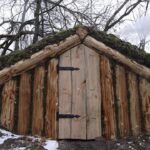How to Preserve Food at Home Safely
Hello. I’m Kathy Riggs, UtahState University Extensionprofessor for familyand consumer sciences. The question I will answertoday is regarding home foodpreservation safety. After all, home foodpreservation safetyis priority number one. Have you ever asked yourselfthe question, how can Ibe sure the foods Ihave preserved at homeand placed on my storage shelvesare safe for my family to eat?Looking for visible evidenceof spoilage such as mold,a lack of a seal, perhaps thefood is slimy to the touch,or there’s an off color–these are all agreat place to start. However, before you prepareyour next batch of peachesor green beans forprocessing, I wouldlike to review fivekey guidelines providedby science- andresearch-based resources thatwill help you guaranteethat your home preservedfoods are safe. Guideline number one is touse current and tested canningrecipes. Food preservation is the processwe follow to treat and handlefood to keep it from spoiling. We want to prevent spoilageand remove harmful bacteriain the safest way possible. Thankfully, sciencehas come a long wayin maximizing ourmargin of safety that isif we adhere to those findings. There are four highlyrecommended sourcesof what we call tested recipes. First is the USDA’s CompleteGuide to Home Canning. Next is So Easy to Preservefrom the University of GeorgiaExtension Service. Third is the Ball BlueBook Guide to Preserving. Also, for those who preferto have an electronic sourceof tested recipes,the National Centerfor Home Food Preservationat www. nchfp. uga. eduutilizes USDA-endorsedrecipes and includes accessto the Complete Guideto Home Canning. Guideline numbertwo is to use onlyapproved, up-to-datecanning methods. Food preservationusing moist heatis generally referredto as canning. Now, there are two main methodsapproved for preserving foodusing heat and moisture, whichis water, namely, pressurecanning and water-bath canning. Pressure canning is theonly approved methodfor low acid foods such as meat,poultry, fish, and vegetables. These foods have the potentialfor causing botulism foodpoisoning. Therefore, theymust be processedusing enough pressure toreach 240 degrees Fahrenheitinside the canner. And that level ofpressure must bemaintained forthe amount of timelisted in the approved recipe. To reach 240 degrees Fahrenheitat altitudes above sea level,additional pressuremust be added. These requiredadjustments can bemade using either thedial or weighted gauges. Water bath canning is usedfor high acid foods includingmost fruits, pickles,acidified tomatoes,and many tomato-basedproducts like salsa. I should also mention that newinformation for safely usingsteam canners for high acidfoods has been released. The update is found on theNational Center for Home FoodPreservation website. That link is postedfor you here. Guideline number three isto follow canning directionsexactly. The easiest way to undothe time and effort putinto producing a high-qualitypreserved food item,is to treat the process lightly. Remember the mention earlierof science and research?When it comes tofood preservation,it’s crucial andin some cases, lifesaving to pay attention to andfollow instructions exactly. The area that can beadjusted is in the amountof herbs and spices. For example, youcould choose to putin less salt and morecilantro or more blackpepper and less cayenne pepper. Guideline number four–make altitude adjustmentsby adding more timeto water-bath canningor increasing pressure forpressure-canned products. Not all bacteria, mold, spores,et cetera, are created equal. Or in other words,not all bacteriaare killed at the same rateor at the same temperature. That is why some foodscan be processed safelyusing water bathcanning, and othersneed temperatures that can onlybe achieved under pressure. Processing methods and times,found in approved recipesand guidebooks, havebeen calibrated properlyto preserve foods by removingoxygen, destroying enzymes,preventing growth of undesirablebacteria, yeast, and molds,and help form a highvacuum seal in jars. Whether you add timeor increase temperaturewhen preserving foodsat your altitudedepends on if you liveat sea level or not. Please search foraltitude tablesin the canning guide youchoose to use and match itto your respective altitude. The National Center for HomeFood Preservation and USDAinclude those charts and tablesright along with the recipe. And guideline number 5 is tomake certain canned productshave a proper lid seal. Good vacuums form tightseals which keep liquid in,and air and microorganisms out. A tight seal is generally onethat cannot be broken withoutthe assistance of a can opener. Let me demonstratewhat that sounds like. I’ll just take this rim off. And listen closely. There we go. So a strong tightseal alone, however,does not mean the contentsin the jar are safe to eat. It’s also necessary tofollow the previous fourguidelines to be 100% certain. To review the keypoints needed to assureyou have safelyprocessed foods–First, use currentand tested recipes. Number two, use onlyapproved canning methods. Number three, followdirections exactly. Number four, make thosealtitude adjustmentsfor time and temperature. And finally, number five,make certain canned productsare properly sealed.



